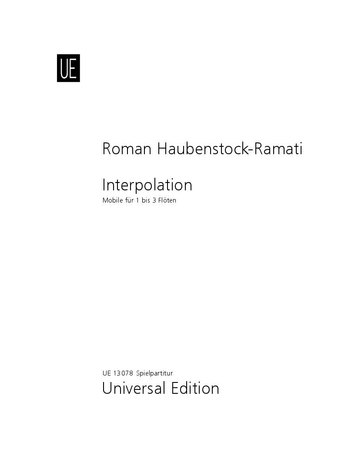

Roman Haubenstock-Ramati
Interpolation
Duration: -'
Dedication: pour darmstadt et severino gazzeloni
Haubenstock-Ramati - Interpolation for 1-3 flutes (or tape recordings)
Translation, reprints and more

Roman Haubenstock-Ramati
Haubenstock-Ramati: Interpolation - Mobile for 1, 2 or 3 flOrchestration: for 1, 2 or 3 flutes
Type: Spielpartitur
Work introduction
Haubenstock-Ramati's Interpolation was written in 1958 and dedicated to Darmstadt and Severino Gazzelloni".
Interpolation is subtitled “mobile pour flute 1,2 et 3”. The term mobile is borrowed from sculpture, where it describes a particular kind of work. The artist creates a number of constituent shapes but stops short of fixing a final overall form for his work. Instead he arranges it in such a way that the component parts move individually, providing a constantly shifting pattern. The sculpture is in a sense "finished" since all the component parts themselves are complete but it has no fixed form. The musical equivalent has a number of completed sections whose order is left to chance in some way. Normally this is done by dividing the music into squares or areas, whose ordering is left to the performer. He may need to plan this in advance, or in consultation with the other players, or it may be left to the spur of the moment. Some pieces in mobile form impose restrictions on which parts may be played together or even make the manner of performing a given part dependent on the particular part which preceded it.
Interpolation consists of twenty-five fragments of varying lengths. Haubenstock-Ramati has provided a network of paths by which the flautist may switch from one fragment to another – in some respects it is not unlike a game of snakes and ladders.
Each performance of the work is different and up to three performances may be given simultaneously. This may be achieved by employing more than one instrumentalist, or by a single flautist pre-recording one or two versions.
